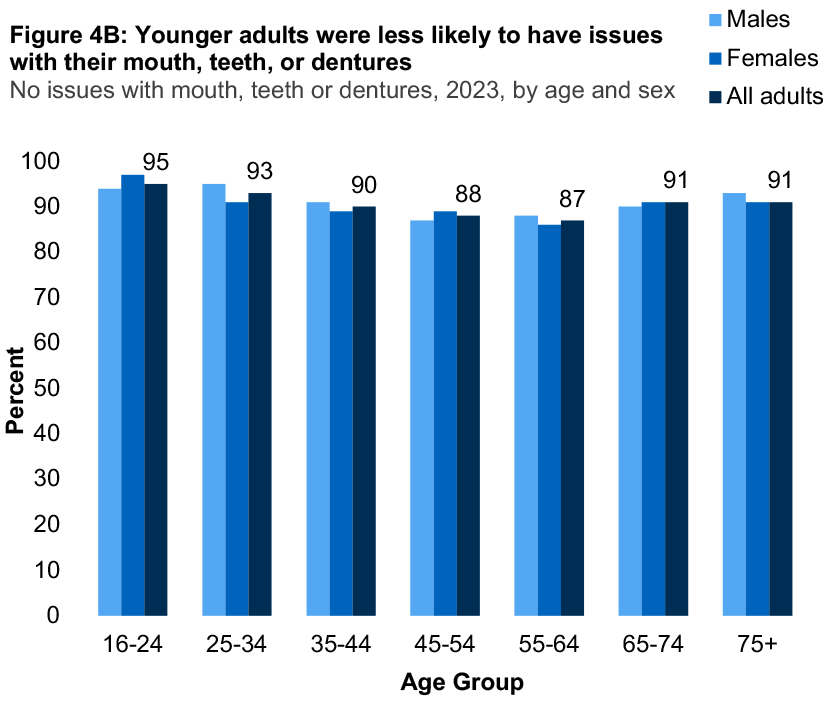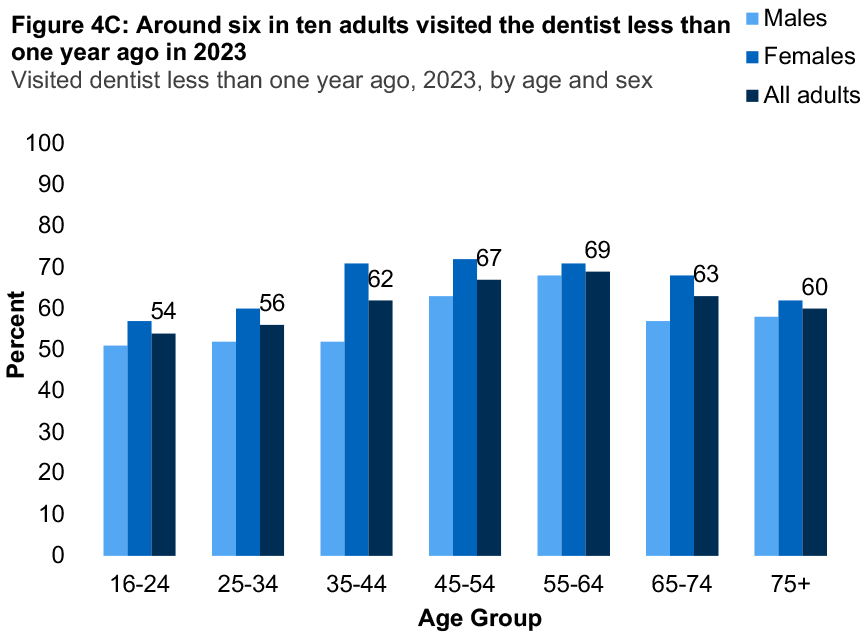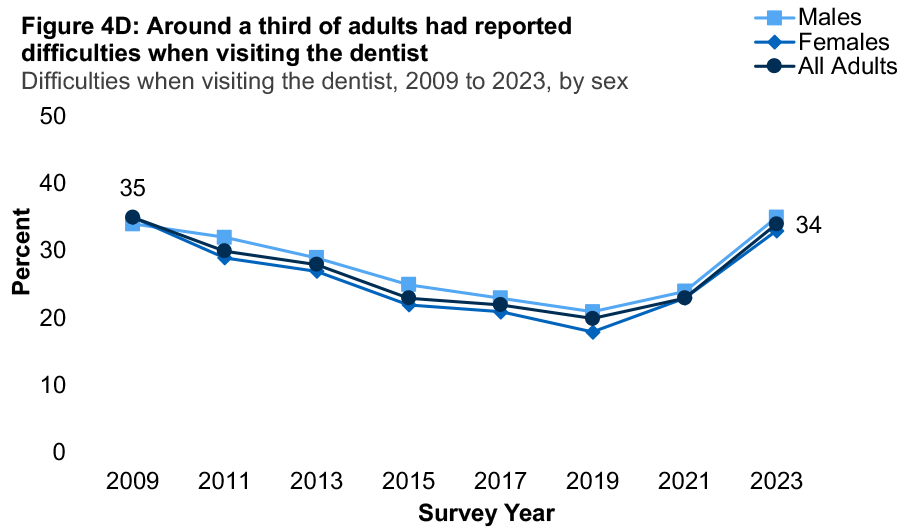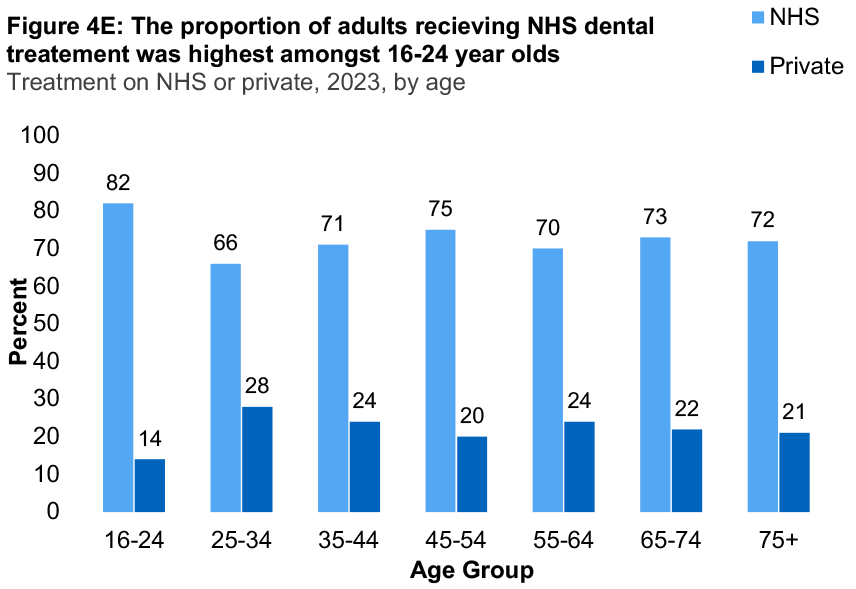The Scottish Health Survey 2023 - volume 1: main report
This report presents results for the Scottish Health Survey 2023, providing information on the health and factors relating to health of people living in Scotland.
4 Dental Health
Rory McClelland
4.1 Introduction
Oral disorders, including tooth decay, affect just over two-fifths of the world’s population[77]. The WHO report that tooth decay is the most common non-communicable disease (NCD) globally yet is largely preventable. It is widely recognised that an unhealthy mouth has a significant impact on physical health as well as on other aspects of day-to-day life including eating, sleeping, missing school or work and engaging with others socially and as a result, may have wider socio-economic consequences[78],[79]. Access to oral health provision was negatively impacted by the Covid-19 pandemic, including a disproportionate impact on groups already predisposed to poorer oral health such as deprived communities and those with chronic conditions/comorbidities[80].
Oral health can both affect and be affected by mental health. For example, mental health issues can lead to neglect of oral hygiene, avoidance of dental visits, overbrushing and/or issues caused by medication[81]. Oral health issues can also result in physical pain, social isolation/withdrawal and/or an overall reduction in quality of life that have the potential to impact on an individual’s mental wellbeing3.
Oral cancer is the oral condition of greatest concern due to its seriousness and increasing incidence[82], particularly in Scotland when compared with the rest of the UK. Major risk factors for oral cancer include tobacco use, excessive alcohol consumption and physical inactivity, with incidence higher among men, older age groups and those who are socioeconomically disadvantaged[83].
4.1.1 Policy background
The First Minister’s Policy Prospectus (2023) set out the Scottish Government’s primary objective to sustain and improve equitable patient access to NHS dentistry. As part of this commitment, Scottish Government introduced significant reform to the NHS dental payment system on 1 November 2023.
The new fee structure was designed to incentivise dentists to provide more NHS care and remain within the NHS. The reform also provides NHS dentists with a comprehensive range of NHS treatment options that enables improved clinical discretion.
The foundation of the reform builds on and incorporates many of the commitments from the Oral Health Improvement Plan (2018), which was developed following one of the biggest consultations with the dental sector in recent times.
The new system is the first step towards a modern NHS dental service which appropriately assesses and supports the oral health needs of all NHS patients in Scotland. Through the new fee structure there are increased incentives to ensure dentists focus on prevention, putting this at the centre of the care provided. Patients will also benefit from treatment items being brought in line with current best practice guidance, particularly around periodontal (gum) treatment, helping maintain and improve oral health.
Alongside this, Scottish Government continues to fund 5 Oral Health Improvement Programmes and several other initiatives to support more vulnerable groups. The Programmes are targeted at older people living in care homes, homeless people, offenders in prison and people with special care needs, as well as children through the flagship Childsmile programme. Childsmile supports a range of measures both in dental practices and in schools, nurseries and the community. In recent years we have seen the success of the programme through significant improvements in child oral health and a narrowing in child oral health inequality.
4.1.2 Reporting on dental health in the Scottish Health Survey
In this chapter, the following data are presented for adults:
- number of natural teeth
- issues with mouth, teeth or dentures and length of time since last visit to the dentist
- difficulties when visiting the dentist
- whether treatment was received from the NHS or privately
Figures are reported by age and sex.
Please note that some caution should be exercised when interpreting data for 2021 within any time series data presented due to some methodological changes during the pandemic. Please see the Scottish Health Survey 2022 - volume 2: technical report for more information.
4.1.3 Comparability with other UK statistics
The Health Survey for England[84], Health Survey Northern Ireland[85] and the National Survey for Wales[86] provide estimates of dental health prevalence in the other UK countries. The surveys are conducted separately and have different sampling methodologies, so dental health prevalence estimates across the surveys are only partially comparable.
4.2 Results
Summary points
In 2023:
- The majority (94%) of adults had at least some natural teeth and this decreased with age from 99-100% of those aged 16-44 to 76% of those aged 75 and over.
- Around six in ten (62%) adults visited the dentist less than one year ago with females (66%) more likely than males (58%) to have done so.
- The proportion of adults reporting difficulties when visiting the dentist (34%) has increased since 2019 (20%) and 2021 (23%) and has returned to a similar level as that recorded in 2009 (35%).
- The most common difficulties reported when visiting a dentist were: getting a suitable appointment (12%), dental treatment being too expensive (10%) and not being able to get dental treatment under the NHS (7%).
- Just under three quarters of adults who had visited a dentist in the last five years had received dental treatment only on the NHS (72%), with those aged 16-24 the most likely (82%) and those aged 25-34 the least likely to receive only NHS treatment (66%).
4.2.1 The proportion of adults that reported having any natural teeth decreased with age
In 2023, 94% of adults reported having at least some natural teeth, and 80% of adults reported having 20 or more natural teeth.
Prevalence of natural teeth varied by age with the majority of adults aged 16-44 (99-100%) having at least some natural teeth in 2023, decreasing with age to 87% among those aged 65-74 and 76% among those aged 75 and over.
There was no significant difference in prevalence of natural teeth by sex.

4.2.2 The majority of adults have no issues with their mouth, teeth or dentures
In 2023, the majority of adults (90%) reported having no issues with their mouth, teeth or dentures.
The two most common issues adults reported having with mouth, teeth and dentures were difficulty in eating food (6%), and/or difficulty smiling, laughing and showing teeth without embarrassment (5%).
Adults aged 16-24 were most likely to report having no issues with their mouth teeth or dentures (95%), while adults aged 45-54 and 55-54 were most likely to report having one or more issues with their mouth, teeth or dentures (12% and 13% respectively).

4.2.3 Younger adults were least likely to have visited the dentist in the past year
In 2023, 62% of adults visited the dentist less than one year ago, with females more likely to report visiting the dentist within the last year than males (66% and 58% respectively).
Length of time since the last visit to the dentist varied by age. Adults aged 45-64 were most likely to have visited the dentist within the last year (67%-69%), while the youngest age group, 16-24 year olds, were the least likely to have visited the dentist in the last year (54%). Older adults aged 75 and over were the most likely to have last visited the dentist more than 5 years ago (18%).

4.2.4 The proportion of adults reporting difficulties when visiting the dentist is at the highest point since 2009
In 2023, one third (34%) of adults reported having difficulties when visiting the dentist, an increase from 2019 (20%) and 2021 (23%) and a return to a similar level as that recorded in 2009 (35%).
The most common difficulties reported when visiting the dentist were getting a suitable appointment (12%), dental treatment being too expensive (10%) and not getting dental treatment under the NHS (7%). These difficulties have all increased since 2021 and are similar to levels seen earlier in the time series. This pattern is evident for males and females.

4.2.5 Around three quarters of adults received dental treatment on the NHS
Just under three quarters of adults who had visited a dentist within the last five years received treatment on the NHS (72%) in 2021/2023 combined. Young adults aged 16-24 were most likely to report having only received treatment on the NHS (82%) and least likely to report receiving only private dental treatment (14%), while those aged 25-34 showed the opposite pattern with 66% receiving only treatment on the NHS and 28% only receiving private dental treatment.

Notes
- Some caution should be exercised when interpreting data for 2021 within any time series data presented due to some methodological changes during the pandemic. Please see the 2022 Scottish Health Survey technical report for more information.
Table List
Table 4.1 Number of natural teeth/no natural teeth (adults), 2023, by age and sex
Table 4.2 Issues with mouth, teeth or dentures, 2023, by age and sex
Table 4.3 Length of time since last visit to the dentist, 2023, by age and sex
Table 4.4 Difficulties when visiting the dentist, 2009 to 2023, by sex
Table 4.5 Treatment on NHS or private, 2021/2023 combined, by age and sex
References and notes
1 Tu C, Wang G, Hu Z, Wang s, Yan Q and Liu X. (2023). Burden of oral disorders, 1990-2019: estimates from the Global Burden of Disease Study 2019. Arch Med Sci 19(4): 930-940. doi: 10.5114/aoms/165962 Available at https://www.ncbi.nlm.nih.gov/pmc/articles/PMC10408023/
2 World Health Organisation (2017). Sugar and Dental Caries. Available at: https://www.who.int/news-room/fact-sheets/detail/sugars-and-dental-caries
3 Oral Health Improvement Plan. Edinburgh: Scottish Government. (2018). Available from: https://www.gov.scot/publications/oral-health-improvement-plan/
4 Tiwari T, Kelly A, Randall C, Tranby E & Franstve-Hawley J. (2021). Association between mental health and oral health status and care utilization. Frontiers in Oral Health. Available at: https://www.ncbi.nlm.nih.gov/pmc/articles/PMC8859414/pdf/froh-02-732882.pdf
5 See https://www.dentalhealth.org/mental-illness-and-oral-health
6 Scotland oral cancer awareness campaign (2023). Available at: https://bda.org/about-the-bda/campaigns/oralcancer/Pages/oral-cancer-scotland.aspx
7 Cancer Research UK (2022). Mouth and oropharyngeal cancer: risks and causes. [Online]. Available at: https://www.cancerresearchuk.org/about-cancer/mouth-cancer/risks-causes
8 See: https://digital.nhs.uk/data-and-information/publications/statistical/health-survey-for-england
9 See: https://www.nisra.gov.uk/statistics/find-your-survey/health-survey-northern-ireland
Contact
There is a problem
Thanks for your feedback